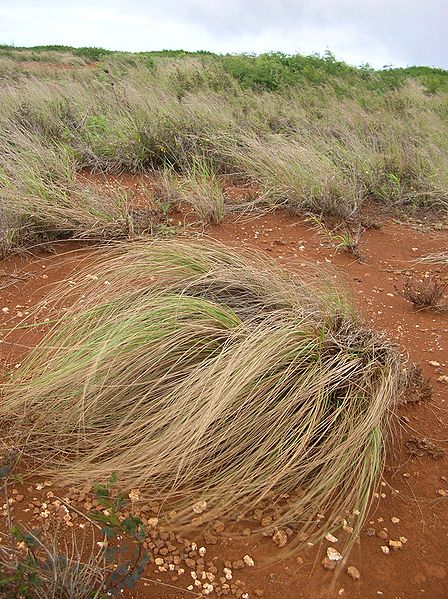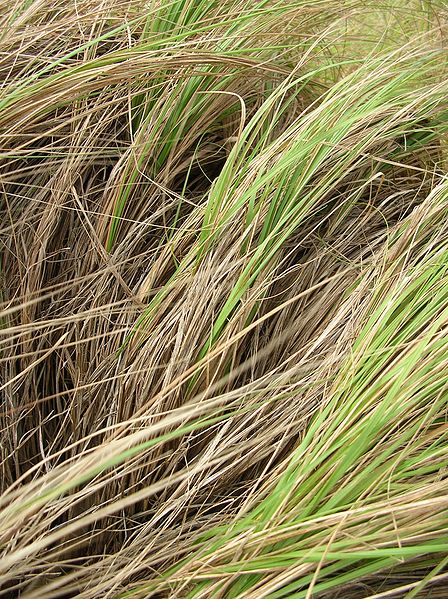 |
|
http://www.hear.org/starr/ |
 |
| http://www.hear.org/starr/ |
Translate this page:
Summary
Physical Characteristics

 Eragrostis curvula is an evergreen Perennial growing to 1.2 m (4ft).
Eragrostis curvula is an evergreen Perennial growing to 1.2 m (4ft).
See above for USDA hardiness. It is hardy to UK zone 7 and is not frost tender. It is in leaf all year, in flower from August to October. The species is hermaphrodite (has both male and female organs) and is pollinated by Apomictic (reproduce by seeds formed without sexual fusion), wind. The plant is self-fertile.
Suitable for: light (sandy), medium (loamy) and heavy (clay) soils and prefers well-drained soil. Suitable pH: mildly acid, neutral and basic (mildly alkaline) soils. It cannot grow in the shade. It prefers moist soil.
UK Hardiness Map
US Hardiness Map
Synonyms
Plant Habitats
Cultivated Beds;
Edible Uses
Edible Parts: Seed
Edible Uses:
Seed - cooked[269]. Used as a grain[269].
References More on Edible Uses
Medicinal Uses
Plants For A Future can not take any responsibility for any adverse effects from the use of plants. Always seek advice from a professional before using a plant medicinally.
None known
References More on Medicinal Uses
The Bookshop: Edible Plant Books
Our Latest books on Perennial Plants For Food Forests and Permaculture Gardens in paperback or digital formats.

Edible Tropical Plants
Food Forest Plants for Hotter Conditions: 250+ Plants For Tropical Food Forests & Permaculture Gardens.
More

Edible Temperate Plants
Plants for Your Food Forest: 500 Plants for Temperate Food Forests & Permaculture Gardens.
More

More Books
PFAF have eight books available in paperback and digital formats. Browse the shop for more information.
Shop Now
Other Uses
Basketry Biomass Soil stabilization
A deep-rooted plant, it is considered excellent for protecting terraces and for grassing water channels and is valuable for erosion control[269]. In Lesotho, the plant is used to make baskets, brooms, hats, ropes, and candles[269].
Special Uses
References More on Other Uses
Cultivation details
Easily grown in most well-drained soils so long as the plant is in a hot, dry, sunny position[200]. Weeping love grass is reported to tolerate an annual precipitation of 31 to 163cm, an annual temperature range of 5.9 to 26.2°C and a pH in the range of 5.0 to 8.2[269]. It is adapted to semi-arid and desert areas and sandy soils, growing well on low fertility soils[269]. A very drought-resistant plant, but it lacks hardiness for more northern areas[269]. It grows well on a wide range of well-drained soils, especially sandy loams; moderately frost-resistant in southern areas[269]. Plants are hardy to about -5°c and succeed outdoors in the milder areas of Britain[200]. The roots contain pyrocatechol, suggesting an explanation for the plants resistance to nematodes[269]. The species and its varieties are apomictic (producing seed without fertilization) although sexual plants have occasionally been found[269].
References Carbon Farming Information and Carbon Sequestration Information
Temperature Converter
Type a value in the Celsius field to convert the value to Fahrenheit:
Fahrenheit:
The PFAF Bookshop
Plants For A Future have a number of books available in paperback and digital form. Book titles include Edible Plants, Edible Perennials, Edible Trees,Edible Shrubs, Woodland Gardening, and Temperate Food Forest Plants. Our new book is Food Forest Plants For Hotter Conditions (Tropical and Sub-Tropical).
Shop Now
Plant Propagation
Seed - sow early spring in a greenhouse and only just cover the seed. Germination should take place within 2 weeks. When they are large enough to handle, prick the seedlings out into individual pots and plant them out after the last expected frosts. The seed can also be sown in situ in mid to late spring, though in a cool summer it may fail to ripen many seeds[162]. Division in spring.
Other Names
If available other names are mentioned here
Native Range
AFRICA: Kenya, Tanzania, Mozambique, Zambia, Zimbabwe, Botswana, Lesotho, Namibia, Eswatini, South Africa (Cape Province, Free State, KwaZulu-Natal, Transvaal)
Weed Potential
Right plant wrong place. We are currently updating this section.
Please note that a plant may be invasive in one area but may not in your area so it's worth checking.
Conservation Status
IUCN Red List of Threatened Plants Status :

Growth: S = slow M = medium F = fast. Soil: L = light (sandy) M = medium H = heavy (clay). pH: A = acid N = neutral B = basic (alkaline). Shade: F = full shade S = semi-shade N = no shade. Moisture: D = dry M = Moist We = wet Wa = water.
Now available:
Food Forest Plants for Mediterranean Conditions
350+ Perennial Plants For Mediterranean and Drier Food Forests and Permaculture Gardens.
[Paperback and eBook]
This is the third in Plants For A Future's series of plant guides for food forests tailored to
specific climate zones. Following volumes on temperate and tropical ecosystems, this book focuses
on species suited to Mediterranean conditions—regions with hot, dry summers and cool, wet winters,
often facing the added challenge of climate change.
Read More
Expert comment
Author
(Schrad.)Nees.
Botanical References
200
Links / References
For a list of references used on this page please go here
Readers comment
| Add a comment |
|
If you have important information about this plant that may help other users please add a comment or link below. Only comments or links that are felt to be directly relevant to a plant will be included. If you think a comment/link or information contained on this page is inaccurate or misleading we would welcome your feedback at [email protected]. If you have questions about a plant please use the Forum on this website as we do not have the resources to answer questions ourselves.
* Please note: the comments by website users are not necessarily those held by PFAF and may give misleading or inaccurate information.
To leave a comment please Register or login here All comments need to be approved so will not appear immediately.
|
Subject : Eragrostis curvula
|
|
|
|